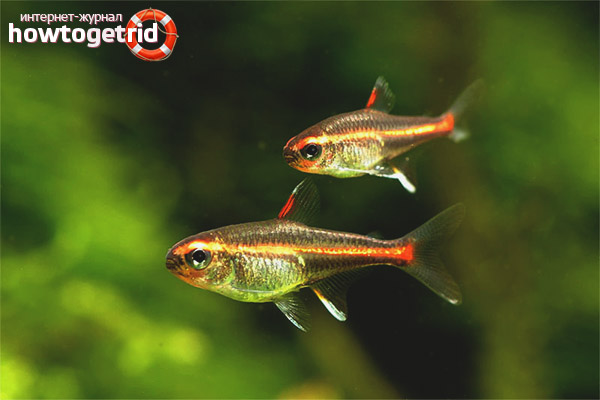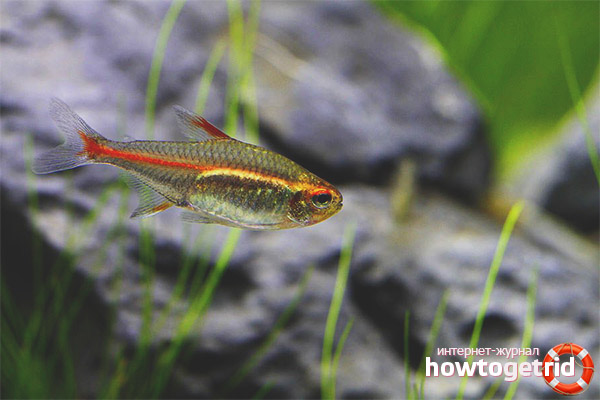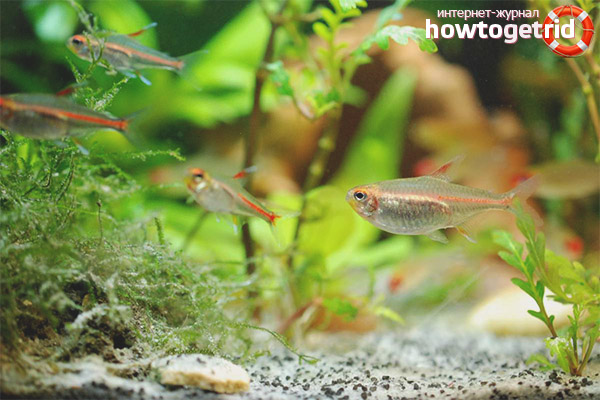The content of the article
Erythrosonus belongs to the tetra family, otherwise the aquatic inhabitant is called a floating firefly or a luminous tetra. A small aquarium fish has long been popular, because it is not whimsical in content, it does not require any special care. Suitable for beginners and professionals who have already mastered this field. A flock of erythrosonuses will attract the attention of even the most avid aquarist, who has seen many species of fish. But let's not run ahead, we will study everything in order of priority.
Description
- For the first time this species of fish was described in 1909, since then a large-scale study and improvement of members of the family has begun. In the natural environment, fish can be found in South America, namely in the Essexibo River.
- Erythrosonuses settle in tributaries of the channel, which are hidden from the eyes by dense forests. The water is brownish and dark from fallen leaves, acidity is elevated or normal, depending on the specific location.
- In their habitat, these representatives of the species prefer to flock to feeding on worms, vegetation and crustaceans. However, to date, fish caught from natural sources do not go on sale. They are all farmed and delivered to aquarium shops.
- Erythrosonuses are otherwise called gracilis. The fish are thin-bodied and do not grow longer than 4 cm in length. With the provision of all conditions for keeping, they will live 3-5 years. In their external features are similar to black neonchiki. Due to the horizontal strip, the fish seems to glow.
- These fish are transparent, on the body along the lateral parts there is a horizontal strip. It goes from the head to the caudal fin. The strip is red-orange, in young animals it is weakly expressed, but in sexually mature individuals it is clearly visible. If the correct lighting is provided in the aquarium, then the erythrosonuses will glow like neons.
- Erythrosone is one of the calmest species of fish. These inhabitants prefer to stray in flocks, so experts advise keeping them for 6-10 individuals or more. For this group, an aquarium with a volume of 60-70 liters is suitable.
- The fish of this family can safely exist in a peaceful aquarium. They get along well with zebrafish, all other tetras, some types of gouras, parsing. If erythrosonuses will have a peaceful temperament, then with proper provision of the water volume, even corridors can be added to them.
- Summing up, we can say that erythrosonuses are quite peaceful and do not require frills in content. They are great for people who are just starting to learn aquariums. It is also worth mentioning separately that the fish are active, they like subdued light.
- It is difficult enough to determine what gender an individual is in front of you. If this is a female, her abdominal region is rounder and her size is larger. The males are brighter and more refined.
Content
- Hardy fish, quickly adapts to the environment. Suitable for inexperienced people who are going to breed aquatic inhabitants. We must say right away that for their full existence they need to be kept in packs. Buy 6-10 individuals at least. Fish need soft water passed through a peat filter.
- To repeat the natural biotope, you need to put dried foliage or peat granules in the fish tank. As the first option, oak, alder foliage is selected. Alder cones will do, but sterilize and dry them first.
- Since these fish will always prefer living in a darkened area, send floating species to the aquarium and install light-scattering lamps if necessary. Remember that fish need space, so it’s best not to plant the middle part of the water with vegetation.
- As the soil, river sand or other filler, which you buy in the store, is selected. It is mandatory to set driftwood, roots, various decor in the form of grottoes, stones, large pebbles, etc. It is good if the driftwood will slightly stain and darken the water.
- Erythrosonuses require shelter, as well as vegetation, but not too dense. As for the parameters of the aquatic environment, fish are kept at a temperature of 23-28 degrees. Acidity should not go beyond the boundaries of 6-7.5 units, and hardness - 2-15 units.
- Aquarium by its nature resembles a confined space. For this reason, it must be looked after. Since fish leave a lot of waste after themselves, it is necessary to periodically replace a third of the water with a new one. For this, 30% of the water is drained once every 15 days.
Feeding
- Erythrosonuses eat everything, so you can prefer live or dried foods, frozen food.
- In order not to upset the balance of the aquatic environment, it is necessary to feed dry pet food in the form of cereal every day.
- Be sure to include small bloodworms, artemia, tubule, etc. in their diet. It is worth feeding the fish with algae. Keep proportions: dry food is given 2 parts, frozen / live - 1 part.
Compatibility
- Erythrosonuses are excellent for keeping in common aquariums, where the same small fish live. To make them feel good, not to fall into stressful situations, it is necessary to keep tetras in groups of 6 individuals.
- If you are going to set up a common aquarium, then give preference to other tetras as neighbors. Minors, blue neons, and rhodostomuses are well suited.
- Earlier it was mentioned that erythrosonus can get along with gouras, corridors, rassbory, zebrafish, viviparous aquatic pets.
Breeding Features
- Fish reproduce by laying eggs. When spawning begins, their fins shrink. Erythrosonuses spawn on vegetation. First, the female lays, then the male fertilizes.
- To get a large number of fry, you need to choose an aquarium with a volume of 35 liters. minimum. Plants, such as Javanese moss or other floating varieties, are placed in a tank dedicated to spawning.
- To protect the eggs, professionals are advised to line the bottom with a net. For breeding, it is necessary to create favorable conditions. So, the temperature regime should not go beyond 26-29 degrees. Fish love soft water with a pH balance of 5.5-6.7 units.
- Granules of peat, which are placed to color the water in a dark color and for the purpose of filtration, will not be superfluous. Some install a conventional filter with a sponge inside.
- Representatives of the group spawn well in cases where about 10-14 individuals live in the aquarium. Half males, half females. Before sending fish to spawn, you need to feed them live feed.
As can be understood from all of the above, it is not difficult to keep fish in aquarium conditions. Everything you need to remember is described in today's material. Do not forget that erythrosonuses will feel great if they are kept in flocks in dark water.












Submit